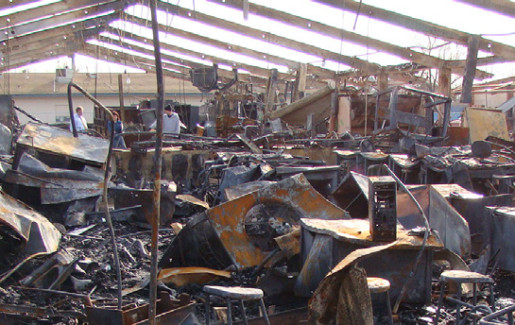Dos Palos Unified School District
School District Suffers Major Fire
Dos Palos Unified School District is located in an agricultural area of the San Joaquin Valley in California, serving over 2,000 students. In December, a major fi re occurred in the agricultural, mechanical, and woodshop area at Dos Palos High School, resulting in two buildings being completely destroyed. Recognizing that the School District had no experience in disasters, how could they confidently and expeditiously adjust their claim?
Problemas
- It was clear that the rebuild would take years to accomplish, so the School District needed temporary classrooms for its displaced students. Because the fire occurred just before the December holidays, there was little time to secure temporary classrooms. Where would these temporary classrooms be placed and how would they be obtained? It was clear that the rebuild would take years to accomplish, so the School District needed temporary classrooms for its displaced students. Because the fire occurred just before the December holidays, there was little time to secure temporary classrooms. Where would these temporary classrooms be placed and how would they be obtained?
- During initial conversations, the insurance company’s consultants felt that the foundations were salvageable, in spite of sustaining extensive heat damage. Concerned for faculty and student safety, the School District needed to be assured the foundations really were safe to reuse.
- The School District did not want to rebuild the classrooms as they had existed because the current high school curriculum no longer needed extensive shop areas. Instead, the School District wanted to shift towards more conventional classrooms, but what would it cost to redesign and rebuild these buildings?
Soluciones Aplicadas
After the School District hired The Greenspan Co./Adjusters International (Greenspan), the Greenspan team scouted the campus and found the school’s tennis courts would be a suitable location for temporary classrooms. However, the process would involve removing the courts and regrading the site. Also, because these were laboratory-type classrooms, they had to be structurally stronger than standard rental classrooms. Using Greenspan’s contacts, the team had these units custom-built, expedited, and installed before school restarted in January. In addition, Greenspan was able to convince the insurance carrier to authorize the restoration of older tennis courts to replace the ones that had just been removed. This included resurfacing the courts and installing new lights. After the School District hired The Greenspan Co./Adjusters International (Greenspan), the Greenspan team scouted the campus and found the school’s tennis courts would be a suitable location for temporary classrooms. However, the process would involve removing the courts and regrading the site. Also, because these were laboratory-type classrooms, they had to be structurally stronger than standard rental classrooms. Using Greenspan’s contacts, the team had these units custom-built, expedited, and installed before school restarted in January. In addition, Greenspan was able to convince the insurance carrier to authorize the restoration of older tennis courts to replace the ones that had just been removed. This included resurfacing the courts and installing new lights.
Greenspan arranged for the temporary units to be available for purchase by the School District with the rental funds paid by the carrier to accommodate the prolonged rebuilding schedule. Greenspan’s team documented the cost of the units as support for their argument that the costs should be paid to the School District and applied to the purchase of the temporary classrooms. As a result, the School District obtained 12 additional classrooms paid for through their extra expense coverage.
Finally, because there would be a few years before the School District rebuilt these structures, incorporating the rebuild into a long-term master plan, Greenspan arranged for a compromise settlement on the withheld depreciation and code upgrades that would otherwise have been available only if the School District rebuilt.
To determine if the foundations were salvageable, Greenspan consulted with engineers and arranged for destructive testing, which revealed the foundations were not useable. The carrier disputed the test results, but Greenspan countered that using the existing foundations and bringing them up to code would be far more costly than replacing them.
The School District made it clear to Greenspan that it had no desire to rebuild using the previous design. Both Greenspan and the insurance company agreed to have four contractors prepare bids, two chosen by Greenspan and two by the carrier. The bids resulted in major differences in the bottom line, the two by the insurance company being the lowest by far. Greenspan’s construction consultant discovered numerous misevaluations by the carrier’s consultant and was able to convince them to agree to one of the two bids Greenspan had obtained.
Salir
By relying on the claims expertise of The Greenspan Co./Adjusters International, Dos Palo High School rose from the ashes, complete with modern classrooms to fit its current needs. The TGC/AI team guided the School District through the complex process, which helped put the School District on the road to recovery. Most importantly, The Greenspan Co./Adjusters International arranged to have custom-built classrooms available to house existing students, which allowed the school to resume its regular schedule on time.
..until we had a big fire, we were an asset to them. We became a liability. Perhaps the facts illustrate the point best: Travelers initially estimated our building loss at $2.8 million. You settled it for $6.4 million plus $770,000 for code upgrades. Travelers initially evaluated our personal property at just over $750,000. You settled our personal property claim for $1.9 million. It is clear to us that you and your firm serve the community well. Your interests are aligned with those of your clients. Yes, you get paid handsomely, but you earn it and deserve it when you retain results like you did for us.


